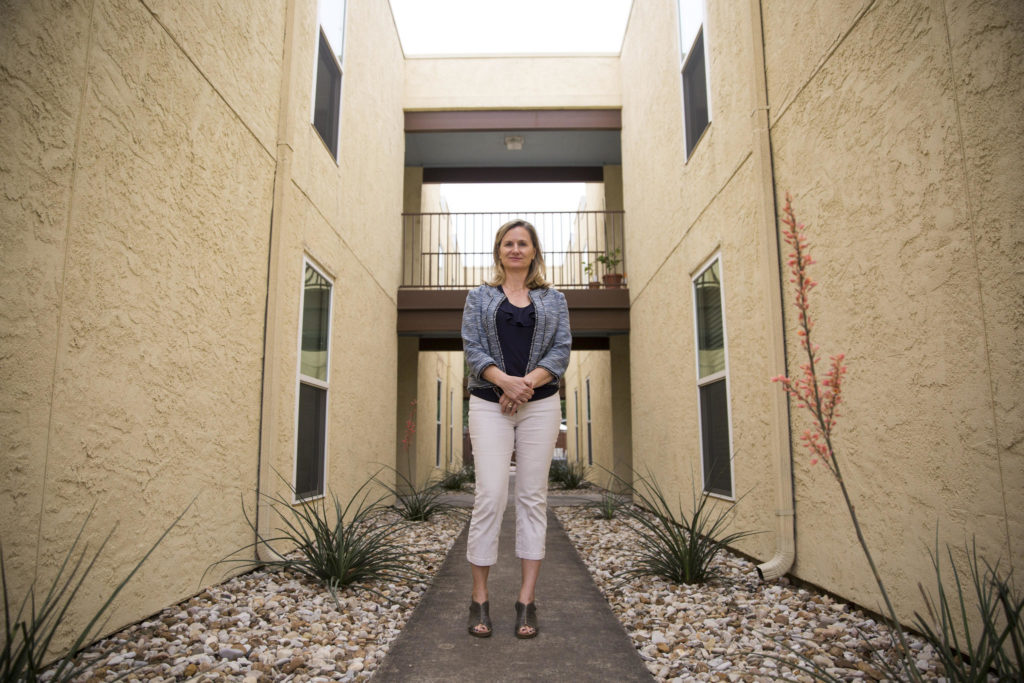What is ‘missing middle’ housing?
Thursday, May 25, 2017 by
Audrey McGlinchy, KUT Annette Naish used to work for the Federal Emergency Management Agency, traveling across the U.S. responding to natural disasters.
“I found out that in this country there are some of the most wonderful people in the history of the Western world,” she said.
Now that she’s retired, Naish tends to stay in North Austin, at her home in the Rundberg neighborhood. When she was looking to buy a house in the late 1990s, this two-bedroom house with 1 ½ baths was perfect. Her kids were grown, and she didn’t want the upkeep that comes with a single-family home.
“As far as I’m concerned, not having to own a lawnmower is fine,” said Naish, who bought the home for $57,000.
Naish lives in a fourplex, or one unit in a group of four attached homes. It’s a rare breed in Austin. Some say it’s missing.
What is the missing middle?
The term “missing middle” housing was coined by the head of Opticos Design Inc., the consultant helping the city of Austin with CodeNEXT, the rewrite of the land development code. Typically, the term refers to housing with anywhere from two to 50 units – though that limit has been stretched. This can mean duplexes, town homes and small apartment complexes.
It’s called “missing” because in many cities it’s hard to find.
Researchers at the University of Southern California Price School of Public Policy recently found that the construction of missing middle housing peaked in the 1970s and ’80s. (Naish’s fourplex, for example, was built in 1972.) But since 1990, the construction of missing middle housing has made up only about 15 percent of new housing stock in the U.S.
That’s particularly true in Austin.
What are the advantages of building the missing middle?
Missing middle housing can offer affordable options compared to other housing options in a city.
“What we know is that a single-family home is an expensive housing product because you’ve got one unit sitting on one parcel of land,” said Mandy De Mayo, executive director of HousingWorks Austin, an affordable housing advocacy group. “And if you can allocate the land costs to multiple units it makes it a little bit more affordable.”

Mandy De Mayo says missing middle housing can offer more affordable options and provides choice.
De Mayo is clear to define “affordable” here.
“That doesn’t mean that it’s deeply affordable or affordable to people who are very low-income, but it makes it a little bit more affordable,” she said.
De Mayo stood outside a 39-unit apartment complex, the exterior boasting a noisy blue- and beige-striped paint job, on West North Loop Boulevard. The building, built in 1972, markets one-bedroom apartments for $1,050 a month, and two-bedrooms between $1,200 and $1,350.
De Mayo said the greatest affordability may be found in older missing middle housing. Down the street, Camden Lamar Heights, built in 2014, has more than 300 units, with one-bedrooms starting around $1,450 and two-bedrooms for around $1,800. (It’s important to note that Camden offers more amenities than the older apartment building on North Loop.)
In 2014, HousingWorks analyzed 50 older small apartment complexes in Austin, totaling 785 market-rate units. It found that more than half of these units were affordable to people making 60 percent of the MFI, or median family income. (In 2014, that equated to $45,240 per a family of four.)
When researchers at USC compared rental prices for different types of housing of the same age, missing middle housing tended to be the cheapest option.
“SMMF (small and medium multifamily) has the lowest rents compared to single-family or large buildings created in the same decade, going back as far as buildings built in the 1950s,” researchers wrote.
Outside discussions of affordability, De Mayo said, missing middle housing simply provides choice.
“A single-family home is really designed for a family,” she said. “Well, what happens when you age and you no longer want a 2,000-square-foot home? Where do you go? The idea would be that in your neighborhood, you don’t have to move to a different part of the city or a different city. There would be other options for you.”
Why don’t we see it in Austin?
“In the city of Austin, we do a really good job of single-family housing and large multifamily housing complexes,” DeMayo said.
Between March 2015 and March 2016, the city permitted single-family homes at nearly six times the rate of units in two-, three- and four-family buildings. (Beyond that, a permitting number was available only for building with “five or more” units.)
“One of the main impediments is that the zoning is not there to support missing middle housing,” said Greg Dutton, a senior planner with the city of Austin.
Much of the city’s inner neighborhoods are zoned SF-3, or single-family zone 3. That only allows up to two units to be built per lot.
When a builder does want to construct three units or more on one lot, it triggers a multilevel review process at the city unlike for single-family or duplex construction.
“It’s much more extensive; you have to show a lot more on your plans about how you’re complying with drainage and parking and traffic,” Dutton said.
One of the goals of CodeNEXT is to make building missing middle housing easier – to make it, well, less missing from Austin.
Naish, for one, is a fan of that plan.
“I think if they city were really thinking, they would build a lot of places like this,” she said, pointing at her fourplex.
This story was produced as part of the Austin Monitor’s reporting partnership with KUT. Photos by Gabriel Cristóver Pérez / KUT.
The Austin Monitor’s work is made possible by donations from the community. Though our reporting covers donors from time to time, we are careful to keep business and editorial efforts separate while maintaining transparency. A complete list of donors is available here, and our code of ethics is explained here.
You're a community leader
And we’re honored you look to us for serious, in-depth news. You know a strong community needs local and dedicated watchdog reporting. We’re here for you and that won’t change. Now will you take the powerful next step and support our nonprofit news organization?










